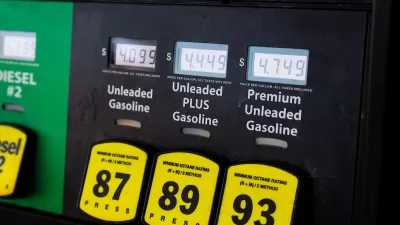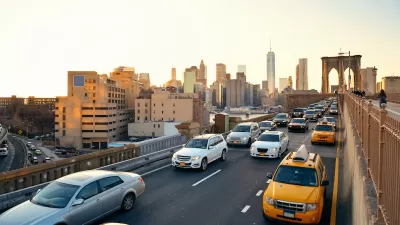Eric Jaffe reports on new research by urban travel behavior expert Bradley Lane of U. of Texas/El Paso on elasticity of gas prices and bus and rail ridership. Interestingly, rail ridership spiked twice as much as bus ridership when gas prices rose.
More well-known is the connection of land use, particularly residential density, to public transit, than gas prices, adding to the value of Lane's research. Lane's premise is that America's love for the automobile can partially be attributed to the underpricing of gasoline. In addition to elasticity, Lane reports on the 'lagged effect' - the fact "that some elasticities - such as switching your commute from car to train - don't appear until several months after the initial change in fuel cost."
"Lane examined fluctuations in gas prices in 33 U.S. cities during a period stretching from January 2002 to March 2009. He then compared these changes to transit ridership patterns in the same cities over the same time.
In all cities he looked at bus ridership, while in 21 places, including Los
Angeles and Chicago and Washington, he considered rail travel as well.
Lane found a pretty strong link between changes in gas prices and shifts in transit ridership. Every 10 percent increase in fuel costs led to an increase in bus ridership of up to 4 percent, and a spike in rail travel of up to 8 percent. ..."
From report abstract: "The results indicate a small but consistently significant amount of transit ridership fluctuation is due to gasoline prices... There is considerable variability across cities in the magnitude of the effect on transit ridership...The results are discussed in light of their implications for transit operations, using cost to influence travel behavior, and transportation sustainability."
Thanks to Pat Carstensen
FULL STORY: How Americans Really React to High Gas Prices

Study: Maui’s Plan to Convert Vacation Rentals to Long-Term Housing Could Cause Nearly $1 Billion Economic Loss
The plan would reduce visitor accommodation by 25,% resulting in 1,900 jobs lost.

North Texas Transit Leaders Tout Benefits of TOD for Growing Region
At a summit focused on transit-oriented development, policymakers discussed how North Texas’ expanded light rail system can serve as a tool for economic growth.

Why Should We Subsidize Public Transportation?
Many public transit agencies face financial stress due to rising costs, declining fare revenue, and declining subsidies. Transit advocates must provide a strong business case for increasing public transit funding.

How to Make US Trains Faster
Changes to boarding platforms and a switch to electric trains could improve U.S. passenger rail service without the added cost of high-speed rail.

Columbia’s Revitalized ‘Loop’ Is a Hub for Local Entrepreneurs
A focus on small businesses is helping a commercial corridor in Columbia, Missouri thrive.

Invasive Insect Threatens Minnesota’s Ash Forests
The Emerald Ash Borer is a rapidly spreading invasive pest threatening Minnesota’s ash trees, and homeowners are encouraged to plant diverse replacement species, avoid moving ash firewood, and monitor for signs of infestation.
Urban Design for Planners 1: Software Tools
This six-course series explores essential urban design concepts using open source software and equips planners with the tools they need to participate fully in the urban design process.
Planning for Universal Design
Learn the tools for implementing Universal Design in planning regulations.
City of Santa Clarita
Ascent Environmental
Institute for Housing and Urban Development Studies (IHS)
City of Grandview
Harvard GSD Executive Education
Toledo-Lucas County Plan Commissions
Salt Lake City
NYU Wagner Graduate School of Public Service




























